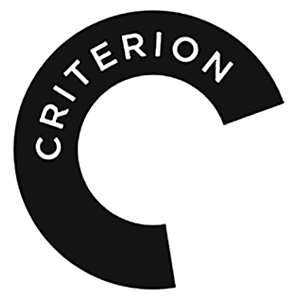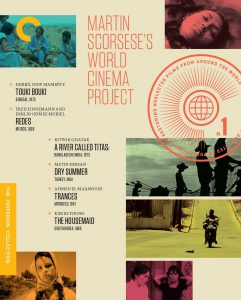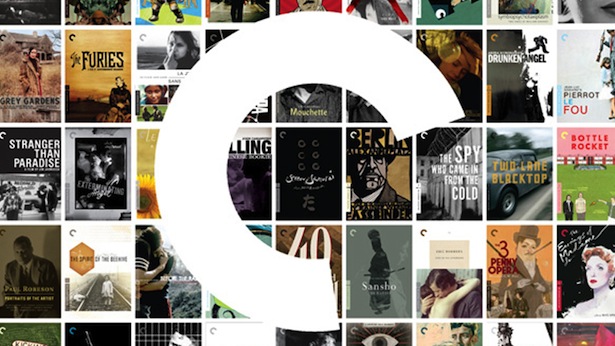As a staple of the home video market since the mid 1980’s, the Criterion Collection has worked endlessly to restore, preserve, and present films in the best possible home video fashion. Choosing classics, foreign, and nearly lost/forgotten films, they work tirelessly to acquire the licensing rights to restore and showcase films to the cinephile community with presentation value that is second to none. They also care deeply about adding value to each release, with cover artwork being thoughtful, as well as pioneering special features for home video release with commentaries, behind-the-scenes interviews, and critical analysis visual essays. Their contributions to laserdisc, DVD, and Blu-Ray have changed the landscape of watching films for always. I will also cover the evolving streaming landscape that the famous collection has traveled in an ever-changing digital age. Overall, I look forward to enriching my own sense of film archiving and sharing with those who appreciate film preservation and presentation as well.
After nearly 35 years of existence, the mission of Criterion is as strong and relevant as ever. Acting as film historians, restorations, curators, and archivist has always been their mission, and as technology and film changes their high standards continue to improve upon the products and services they provide. David Bordwell speaks on the nature of Criterions archival work, saying “Restoration, which is the archival task most visible to the film-loving public, goes further. It involves working to bring the film back to some- thing like an original state” (Bordwell, 178). Leading the way, they have created the template for excellent work and their impact on the home media landscape is tremendous. They have branched out not just as a physical media giant, but as innovators in film programming in a digital age, offering more than just the feature films themselves. In his book Film Programming, Peter Bosma claims “film art should be protected in this hostile environment of market operations through convincing justifications and celebrations” (Bosma, 115).

An early logo for the Criterion Collection
Film curation has taken on an evolution as long as the medium itself. With theaters and eventually film festivals dominating the format in which films could be viewed, the advent of television in the 1950’s and eventually the idea for “movie rentals” in the 1980’s opened the door to a larger form of consumption for the film-enjoying public, the intimacy of seeing films at home. Still, the inconvenience of timeframes of seeing classic and foreign films on TV, as well as restrictions of renting a film on VHS didn’t allow cinephiles to satisfy their appetites, and owning a large collection of films at that time was unheard of. In 1984, a group of Californian cinephiles were curious about the new home video format “laserdisc”, with capabilities to add supplements to films and mono tracks, and they were impressed with their first two film exhibitions Citizen Kane and King Kong (Crowdus, 48). Kane was purchased for $10,000 from RKO studio, and the transfer process to laserdisc was famously “historic” in its care by Criterion founder Roger Smith (Parker, 47). This group also pioneered the idea to allow film makers and film scholars record commentary tracks, adding a distinct value to their product. Robert & Aleen Stein, Joe Medjuck, and Roger Smith parlayed their idea into the Voyager company, which would publish educational CD-ROMs as well as distribute the early incarnation of the Criterion Collection. After changing hands in the 1990’s, and partnering with Janus films, the distribution was passed to Imagine Entertainment in 2006 and eventually Sony Pictures in 2013.

A copy of one of the first films Criterion released
Criterion’s mission has been consistent for over thirty years, to archive and present films as faithfully and vibrantly as the film makers intends. They understand the importance of film exhibition in a theater, but for a more repeatable and enjoyable experience at home, standards needed to be raised. They pioneered the necessity to “letterbox” films, which maintain the original aspect ratio of films shot in wider scope than 4:3 TV’s used to be the standardized format. Film makers work in tandem with the Criterion Collection to make sure that once the rights are secured through licensing, that their films are restored as well as possible. Criterion also strives to secure licensing on films that fit their “style” of archiving and curating. Since the home media boom of VHS/DVD/Blu-Ray/4K, studios have released their own films for home media consumption, but Criterion has dug deep to secure the rights to classic of old, forgotten gems thought lost into obscurity. They also will restore foreign films, both classic and contemporary, and flesh out the filmographies of cinemas greatest film makers. To quote James Kendricks in his article about the Collection, “Criterion positions as an archive of film as culture, and not just film as art” (Kendrick, 138).

Criterion creates unique covers, with images from the film or minimalist reference of the films
After Criterion secures the rights to restore and release a film (now on DVD/Blu-Ray), the process is overseen by a special “producer” of each film. That producer is responsible for everything of value that each film presents (source: Criterion FAQ site). Criterion has a reputation of unique and often beautiful artwork for their covers. Improving on generic poster design that many studios offer for packaging, they usually incorporate important stills/reference from each film, or a unique artistic expression (as seen above). Their logo always appears, as does the year and director of each film, often with auteur credit given (i.e. “Fritz Lang’s M”). To keep track of the collection size, each film is recorded with a “spine number” which is currently up to 963. Each producer works in tandem with film makers and film historians to make each release special. Video/Audio perfection is strived for, with a strenuous restoration of old prints of films detailed to look and sound their very best and as originally processed. Commentary tracks, and other special feature supplements such as visual essays and behind-the-scene footage make each Criterion release a value-added film archival treasure. Film scholar Timothy Page praises the Criterion Collection for their attention to detail with special features, and also claiming that their informational material will also inform and entertain general audiences (T.Page, 125).

Criterion’s careful hand restored Bergman’s “Persona” with incredible results
The impact the Criterion Collection has had on the film community is profound. DVD/Blu-ray began to adopt “widescreen” aspect ratio for films, and luckily the prominence of HDTV and surround sound systems began to normalize 16×9 film outputs that would maximize the look of films shot as 1.85:1 and 2:35:1 anamorphic widescreen lens. Studios would see the value in proper film transfers both with video/audio, and special features educating and entertaining audiences. The library and reputation for excellence that Criterion has built is second to none in world cinema archiving. While companies like “Kino Lorber” also archive and promote world/independent cinema, Criterion is still the king of diversity and cinematic clout. Boasting films from Chaplin, Bergman, Kurosawa, Godard, Ozu, Apu, Truffaut, Malick, Kubrick, Spike Lee, Wes Anderson, Scorsese, Denis, Hitchcock, and many more; Criterion offers a vast array of important a valued cinema from all countries, eras, and walk of cinematic life. With a commitment to film appreciation and restoration, they also highlight sets such as “Martin Scorsese’s World Cinema Project”, a set of films that the director and known film restoration savant aim to archive and preserve cherished and important sections of film history. (seen below)

Martin Scorsese worked in tandem with Criterion to curate a film project
Changes in format have always been important for the home video community, but Criterion especially has kept their edge going from laser disc in the mid-1990’s to their last release in 1999, the Michael Bay blockbuster Armageddon. Criterion made a smooth transition to DVD in the new century, as well as high definition Blu-Ray in 2008. Physical media with larger capabilities for well-restored feature films as well as supplements fit perfectly into their goals. The other frontier that Criterion has had to transverse in a growing media age, is that of streaming services. As Netflix and Hulu began to boom as rental and eventually streaming/video-on-demand services, Criterion dipped their toes in the water first with MUBI, offering VOD services in 2008. Later in 2011, they offered a decent portion of their collection to Hulu Plus, which allowed unlimited viewing for their films they allowed to be seen. New York Times writer Ryan Lawler saw this strategy by Hulu and Criterion as strategic, hoping to draw the film community to Hulu while Netflix honed in on the TV crowds (Lawler, 3). Offering just 150 of a possible 800+ films allowed cinephiles to consume the types of films they were used to seeing in their own Criterion films, while also keeping Criterions vast library available for purchase in their traditional method for revenue and profit. Criterion has been criticized at times for prices well above that of competition (often $39.99), but they maintain that the value curated into each release justifies the expense. Their partnership with Barnes & Noble offers both to capitalize on educated and cultured audiences, with B&N frequently offering Criterion films for 50% off a few times each year, with sales boosting revenue for Criterion. (seen below)

Criterion films are sold for modest pricing during a Barnes & Noble 50% off sale
In 2016, Criterion paired with Turner Classic Movies to create the film streaming service “Filmstruck”, an offering of each of their libraries for specific film consumption between both fan bases. The streaming service offered a one-of-a-kind cinematic niche for cinephiles to stream their favorite classic, foreign, and independent films not seen on other on-demand services. Criterion president Peter Becker said in an interview with the Observer that “The mission has always been to use technology in the most interesting ways we can, to serve our audience and our films, and to try to be creative in the application of technology (Brandman, 1). While offering a taste of what their product offers in an easy and convenient manner for their audience, Criterion is able to enhance their prestigious brand as technology evolves. Their highest value is still in the form of physical media, as Filmstruck unfortunately has folded in the fall of 2018.

Criterions interface for Filmstruck

Logo for the soon to launch “Criterion Channel”
Criterion has announced, however, that they will create their own “Criterion Channel” in Spring 2019, after learning the pros and cons of partnership in the streaming world the past ten years. The new channel includes programming with focus on director spotlights and actor retrospectives. Featuring major Hollywood and international classics and hard-to-find discoveries from around the world, complete with special features like commentaries, behind-the-scenes footage, and original documentaries (Inside Criterion, 1). By using multiple platforms to preserve and display the work that film makers, scholars, and historians have achieved in the relatively short time that film has existed as and art and medium, they offer a contextualized and carefully curated collection of film excellence.
Work Cited
Bordwell, David. Pandoras Digital Box: Films, Files, and the Future of Movies. Irvington Way Institute Press, 2013.
Bosma, Peter A. N. Film Programming: Curating for Cinemas, Festivals, Archives. Wallflower Press, 2015.
Brandman, Jake. “Behind the Screens: Criterion Collection President on Classic Movies in Digital Age.” Observer, Observer, 22 Dec. 2016
“FAQ.” The Criterion Collection, www.criterion.com/faq.
“New, Independent Criterion Channel to Launch Spring 2019.” The Criterion Collection
Crowdus, Gary, and Peter Becker. “Providing a Film Archive for the Home Viewer: An Interview with Peter Becker of The Criterion Collection.” Cinéaste, vol. 25, no. 1, 1999, pp. 47–50.
Kendrick, James. “What is Criterion? The Criterion Collection as an Archive of Film as Culture.” Journal of Film and Video, vol. 53, no. 2/3, 2001, pp. 124–139.
Lawler, Ryan “As Netflix Goes After TV Fans, Hulu Chases Movie Buffs.” The New York Times, The New York Times, 15 Feb. 2011
Page, Tim. “Film: All the Extras: When the Criterion Collection Releases a Classic on DVD, the Movie Is Only the Beginning.” The American Scholar, vol. 74, no. 4, 2005, pp. 122–125.
Parker M., Parker D. (2011) Setting the Standard: The History of The Criterion Collection. In: The DVD and the Study of Film. Palgrave Macmillan, New York


Recent Comments